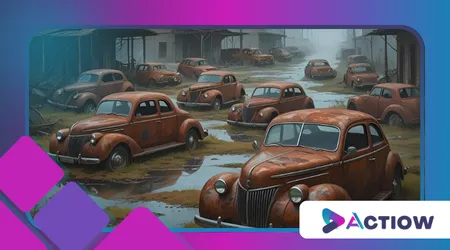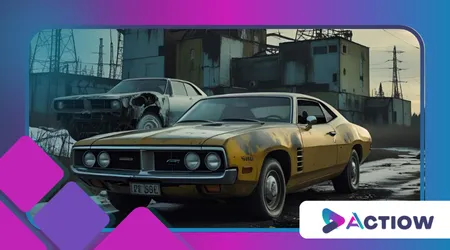The Mysterious Case of the Ghost Cars of Chernobyl
Anúncios
In the shadow of the Chernobyl Nuclear Power Plant, a haunting spectacle lingers: the Ghost Cars of Chernobyl.
These are not spectral apparitions in the traditional sense but rather the rusted, abandoned vehicles left behind after the catastrophic nuclear disaster of April 26, 1986.
Scattered across the Exclusion Zone a 30-kilometer radius around the reactor these cars, trucks, and buses stand frozen in time, their decay a testament to the sudden evacuation that left Pripyat and surrounding areas deserted.
Anúncios
However, their story is more than a relic of tragedy; it’s a window into human resilience, environmental impact, and the eerie beauty of abandonment.
The Enigma of Abandoned Machines

Why do these Ghost Cars of Chernobyl captivate us?
Perhaps it’s their silent narrative, each dented frame and shattered windshield whispering tales of a world abruptly halted.
Unlike the reactor itself, these vehicles are tangible, everyday objects once symbols of normalcy, now artifacts of a disaster that reshaped global perspectives on nuclear safety.
++ Why Cuban Cars Still Look Like It’s 1950
Consequently, exploring their story reveals not only the immediate aftermath of Chernobyl but also the long-term interplay between human activity and nature’s reclamation.
This article delves into the mysterious case of these abandoned vehicles, weaving together historical context, environmental consequences, and cultural significance.
Through original examples, a relevant statistic, an analogy, and a thought-provoking rhetorical question, we’ll uncover why the Ghost Cars of Chernobyl remain a powerful symbol.
++ When France Banned Headlights: A Forgotten War-Time Policy
Additionally, tables and a FAQ section will provide clarity and depth, ensuring a comprehensive exploration of this enigmatic phenomenon.
The Historical Context: A City Frozen in Time

On the night of the Chernobyl disaster, the city of Pripyat buzzed with life.
Home to nearly 50,000 people, it was a model Soviet city, complete with schools, hospitals, and a fleet of vehicles that supported daily routines.
However, when Reactor 4 exploded, releasing radioactive particles across Europe, the city’s pulse stopped.
Residents were evacuated within 36 hours, leaving behind personal belongings, including their cars.
++ Why Soviet Cars Had Built-In Ice Scrapers and Ashtrays
Thus, the Ghost Cars of Chernobyl were born not through supernatural means but through the chaos of human flight.
Among these vehicles were buses used to evacuate residents, left abandoned at depots after their final routes.
Fire trucks, deployed in vain to combat the reactor’s blaze, now rest in fields, their paint peeling under decades of radiation and weather.
For instance, consider a hypothetical scenario: Ivan, a Pripyat bus driver, parked his vehicle at the depot after his last evacuation run, unaware he’d never return.
His bus, now half-buried in overgrowth, stands as a monument to that chaotic day.
Similarly, military vehicles, brought in for cleanup, were abandoned when contamination rendered them unusable.
These examples illustrate how ordinary machines became frozen relics of a catastrophe.
The scale of abandonment is staggering.
According to a 2016 report by the Ukrainian government, over 1,500 vehicles were left in the Exclusion Zone, including 400 buses and 300 fire trucks.
This statistic underscores the sheer volume of machinery discarded, each vehicle a snapshot of the disaster’s immediacy.
Consequently, the Ghost Cars of Chernobyl are not just objects; they’re historical markers, each telling a story of urgency, loss, and survival.
Environmental Impact: Nature’s Reclamation of the Ghost Cars

The Ghost Cars of Chernobyl are not merely relics; they are battlegrounds where nature wages a slow war against human creation.
Over nearly four decades, the Exclusion Zone’s environment has transformed these vehicles.
Rust eats away at metal frames, vines snake through broken windows, and moss blankets dashboards.
Consequently, these cars are becoming part of the landscape, a process that highlights nature’s relentless ability to reclaim what humanity abandons.
Consider a specific example: a Lada sedan, once a common sight in Soviet cities, now sits in a Pripyat parking lot.
Its tires have disintegrated, and a young tree sprouts through its engine block, splitting the metal. This scene, imagined yet plausible, reflects the real ecological dynamics at play.
Radioactive isotopes like Caesium-137 and Strontium-90, released during the disaster, contaminated these vehicles, rendering them hazardous for salvage.
However, nature’s indifference to radiation allows flora and fauna to thrive, entwining with these relics.
Thus, the cars serve as microcosms of the Exclusion Zone’s broader ecological recovery.
An analogy helps frame this phenomenon: the Ghost Cars of Chernobyl are like shipwrecks on an ocean floor, slowly consumed by coral and marine life.
Just as the sea reclaims sunken vessels, the forest reclaims these cars, turning them into hybrids of metal and organic matter.
This transformation raises a question: Can humanity’s creations ever truly resist nature’s persistence?
The answer lies in the Exclusion Zone, where the cars’ decay mirrors the resilience of life in the face of catastrophe.
| Environmental Impact on Ghost Cars | Details |
|---|---|
| Contamination | Vehicles exposed to Caesium-137 and Strontium-90, making them unsafe for human use. |
| Vegetation Overgrowth | Trees, vines, and moss envelop cars, integrating them into the ecosystem. |
| Material Degradation | Rust and corrosion break down metal, accelerated by high humidity and radiation. |
| Wildlife Interaction | Animals use cars as shelters, with birds nesting in interiors and rodents burrowing nearby. |
Cultural Significance: Symbols of Memory and Mystery
Beyond their physical decay, the Ghost Cars of Chernobyl hold profound cultural weight.
They are not just abandoned vehicles but symbols of a lost era, evoking nostalgia, fear, and curiosity.
Photographers, filmmakers, and tourists flock to the Exclusion Zone, drawn by the cars’ eerie allure.
For instance, the HBO series Chernobyl (2019) featured scenes of abandoned vehicles, amplifying their mystique for global audiences.
Consequently, these cars have transcended their original function, becoming icons in popular culture.
The cars also serve as a canvas for collective memory. Imagine a group of former Pripyat residents visiting the Exclusion Zone in 2020, standing before a rusted ambulance that once served their community.
For them, it’s not just a vehicle but a reminder of lives disrupted, families separated, and a city silenced.
This emotional resonance makes the Ghost Cars of Chernobyl powerful storytelling tools, bridging personal histories with global narratives.
Moreover, their presence in video games like S.T.A.L.K.E.R. further cements their status as cultural artifacts, blending reality with dystopian fantasy.
Yet, the cars’ mystique also sparks debate.
Some argue they should be preserved as historical relics, while others see them as hazardous waste, too contaminated for salvage.
This tension reflects broader questions about how we commemorate disasters.
By preserving these vehicles, we honor the past; by leaving them to decay, we acknowledge nature’s dominance.
Thus, the Ghost Cars of Chernobyl challenge us to balance memory with practicality, ensuring their story endures without romanticizing tragedy.
| Cultural Roles of Ghost Cars | Description |
|---|---|
| Tourist Attraction | Draw photographers and adventurers to the Exclusion Zone, boosting dark tourism. |
| Media Representation | Featured in films, series, and games, amplifying their global recognition. |
| Historical Symbol | Represent the sudden abandonment of Pripyat and the human cost of the disaster. |
| Debate on Preservation | Spark discussions on whether to preserve or allow natural decay. |
The Human Element: Stories Behind the Machines
The Ghost Cars of Chernobyl are more than metal husks; they are tied to human stories of sacrifice and survival.
The liquidators cleanup workers who risked their lives post-disaster used many of these vehicles.
Firefighters, for example, drove trucks to the reactor, unaware of the lethal radiation doses they faced.
Consequently, these vehicles are not just abandoned but are memorials to human courage and tragedy.
Their drivers, often hailed as heroes, left behind families and futures, their stories embedded in the cars’ rusted frames.
Consider the liquidators’ buses, which shuttled workers to and from the reactor site.
One such bus, now decaying near the plant, might have carried a young engineer named Oksana, who volunteered despite knowing the risks.
Her story, though fictional here, mirrors the real experiences of thousands who faced radiation exposure.
According to UNSCEAR, 530,000 liquidators were involved in the cleanup, with many suffering long-term health effects.
This statistic highlights the human toll, making the cars poignant reminders of sacrifice.
Furthermore, the Ghost Cars of Chernobyl evoke questions about responsibility.
Who bears the cost of such disasters those who designed the flawed reactor, the operators who made errors, or the workers who cleaned up?
The cars, silent witnesses to these events, prompt us to reflect on accountability and prevention.
By studying them, we learn not only about the past but also about the need for vigilance in nuclear safety, ensuring such tragedies are not repeated.
Ghost Cars of Chernobyl: FAQs
| Question | Answer |
|---|---|
| What are the Ghost Cars of Chernobyl? | Abandoned vehicles in the Chernobyl Exclusion Zone, left behind after the 1986 nuclear disaster due to evacuation and contamination. |
| Are the cars still radioactive? | Yes, many carry traces of Caesium-137 and Strontium-90, though radiation levels are generally safe for short visits. |
| Why weren’t the cars removed? | High radiation levels made salvage impractical, and the sudden evacuation left no time for retrieval. |
| Can visitors touch the cars? | Touching is discouraged due to residual radiation, though short-term exposure is typically low risk. |
| Do the cars still function? | Most are inoperable due to decades of decay, rust, and environmental damage. |
Conclusion: Ghost Cars of Chernobyl
The Ghost Cars of Chernobyl are more than relics of a disaster; they are multifaceted symbols of history, nature, culture, and human resilience.
From their origins in the chaotic evacuation of Pripyat to their role as ecological and cultural artifacts, these vehicles tell a story that transcends their rusted frames.
Through examples like Ivan’s bus and Oksana’s liquidator vehicle, we see the human cost; through statistics, we grasp the scale; and through analogies, we understand nature’s power.
As we reflect on these cars, we confront broader questions about humanity’s relationship with technology and the environment.
Their decay reminds us that even our most durable creations are fleeting against nature’s persistence.
Moreover, their cultural resonance ensures they remain in our collective imagination, urging us to learn from the past.
Ultimately, the Ghost Cars of Chernobyl stand as a haunting reminder: even in the face of catastrophe, stories endure, whispering lessons for those who listen.
